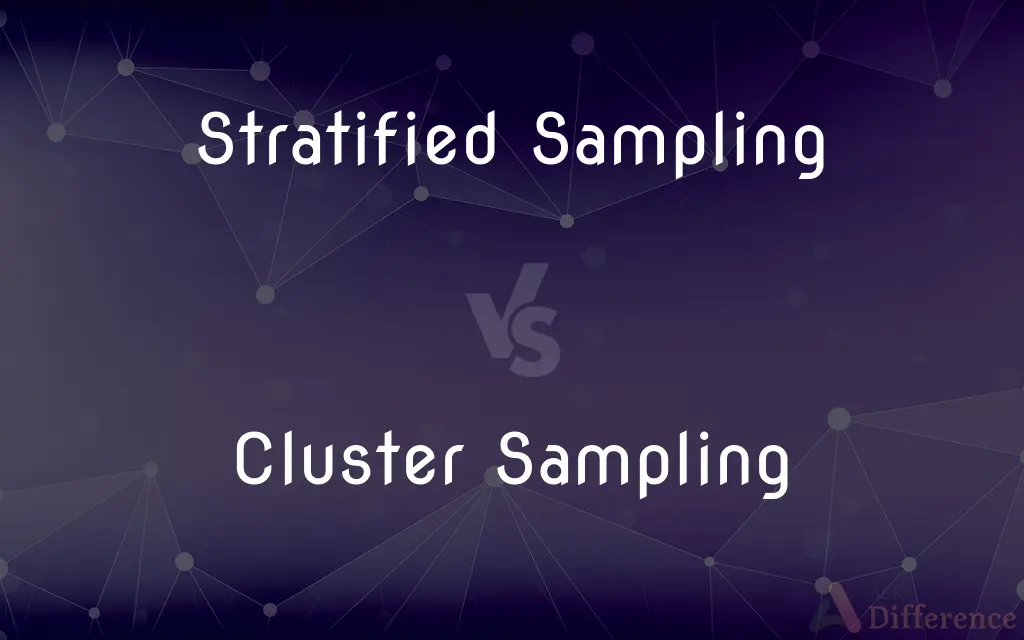Stratified Sampling vs. Cluster Sampling — What's the Difference?
Edited by Tayyaba Rehman — By Fiza Rafique — Published on December 11, 2023
Stratified Sampling divides a population into subgroups and samples from each; Cluster Sampling divides a population into clusters, sampling a few, and surveys all within them.

Difference Between Stratified Sampling and Cluster Sampling
Table of Contents
ADVERTISEMENT
Key Differences
Stratified Sampling is a technique where the entire population is divided into distinct, non-overlapping subgroups, or strata, based on a specific characteristic. Cluster Sampling, on the other hand, divides the population into clusters and only a random sample of these clusters is chosen for a detailed study.
In Stratified Sampling, every member of a stratum has an equal chance to be chosen in the sample. Cluster Sampling randomly selects entire clusters, meaning not every individual in the population has the same chance of being picked.
Stratified Sampling aims to ensure that the sample represents specific subgroups or strata within the population. Cluster Sampling, conversely, is used when studying the entire population is impractical, and it's easier to study a few clusters in-depth.
While Stratified Sampling can reduce sampling error by ensuring representation from all subgroups, Cluster Sampling may introduce more error as only a subset of clusters is chosen, potentially missing out on variability in non-selected clusters.
The essence of Stratified Sampling lies in its focus on the representation of defined strata. Cluster Sampling's essence is in its practicality, simplifying the sampling process by dealing with a few clusters rather than individual members of a population.
ADVERTISEMENT
Comparison Chart
Basic Approach
Divides population into homogeneous subgroups.
Divides population into heterogeneous clusters.
Unit of Sampling
Individual members from each subgroup.
Entire clusters.
Objective
Ensure representation from each subgroup.
Simplify sampling by dealing with clusters.
Error Potential
Reduced, as each subgroup is represented.
Can be higher if clusters aren't diverse.
Practical Use
When certain subgroups need specific representation.
When studying individual units is impractical.
Compare with Definitions
Stratified Sampling
Ensuring diverse subgroups are equally sampled in research.
Stratified Sampling allowed us to get feedback from both new and loyal customers.
Cluster Sampling
A method where the population is split into clusters, with a few randomly chosen for in-depth study.
Due to logistical constraints, we used Cluster Sampling, selecting three cities for our study.
Stratified Sampling
A structured sampling method targeting specific subpopulations.
Through Stratified Sampling, we gained insights from each department in our company.
Cluster Sampling
Sampling technique involving selection of groups instead of individuals.
To understand regional preferences, we chose Cluster Sampling, focusing on entire towns.
Stratified Sampling
A method ensuring every subgroup of a population is represented.
For accurate age data, we used Stratified Sampling, representing every age bracket.
Cluster Sampling
A system that focuses on studying selected clusters fully.
Cluster Sampling allowed us to study school districts as a whole, rather than individual students.
Stratified Sampling
Sampling technique that divides populations into distinct layers.
To understand income differences, Stratified Sampling was used to separate income levels.
Cluster Sampling
Allows researchers to study a sample of groups from a larger population.
For our national survey, Cluster Sampling made it manageable, studying selected neighborhoods.
Stratified Sampling
A system where populations are split based on certain attributes.
Using Stratified Sampling, we separated our data by urban and rural residents.
Cluster Sampling
An approach concentrating on random subsets rather than the entire population.
Using Cluster Sampling, we observed behaviors of selected community groups, not every individual.
Common Curiosities
What is Stratified Sampling?
Stratified Sampling is a technique that divides a population into distinct subgroups and samples individuals from each.
Can Stratified Sampling ensure equal representation from each subgroup?
Yes, Stratified Sampling ensures representation by sampling from each defined subgroup.
Is Cluster Sampling more practical in certain situations?
Yes, Cluster Sampling is often more practical when studying individual units is challenging or impractical.
How is error potential in Stratified Sampling?
Stratified Sampling can reduce sampling error by ensuring representation from all subgroups.
What could be a drawback of Cluster Sampling?
Cluster Sampling may introduce more error if non-selected clusters have different characteristics from selected ones.
When is Stratified Sampling particularly useful?
Stratified Sampling is useful when there's a need to ensure representation from specific subgroups in the population.
How does Cluster Sampling work?
Cluster Sampling divides the population into clusters, and only a random sample of these clusters is studied in-depth.
Why might researchers choose Cluster Sampling over other methods?
Researchers might choose Cluster Sampling for its practicality, especially when dealing with large populations.
What’s a key difference between Stratified Sampling and Cluster Sampling?
Stratified Sampling focuses on representation from all subgroups, while Cluster Sampling studies selected clusters fully.
How do researchers decide the clusters in Cluster Sampling?
Clusters are often naturally occurring groups like towns, schools, or neighborhoods.
Does every individual in Stratified Sampling have an equal chance to be chosen?
In Stratified Sampling, every member of a specific stratum has an equal chance to be selected.
Do all clusters get studied in Cluster Sampling?
No, in Cluster Sampling, only a random sample of clusters is chosen for a detailed study.
Can Cluster Sampling miss out on variability?
Yes, if the selected clusters aren't diverse, Cluster Sampling might miss out on some population variability.
Is Stratified Sampling more precise than Cluster Sampling?
Stratified Sampling can be more precise if the strata are well-defined, while Cluster Sampling might introduce more error.
Are the subgroups in Stratified Sampling overlapping?
No, the subgroups in Stratified Sampling are distinct and non-overlapping.
Share Your Discovery

Previous Comparison
Mystify vs. Perplex
Next Comparison
Cladogram vs. Phylogenetic TreeAuthor Spotlight
Written by
Fiza RafiqueFiza Rafique is a skilled content writer at AskDifference.com, where she meticulously refines and enhances written pieces. Drawing from her vast editorial expertise, Fiza ensures clarity, accuracy, and precision in every article. Passionate about language, she continually seeks to elevate the quality of content for readers worldwide.
Edited by
Tayyaba RehmanTayyaba Rehman is a distinguished writer, currently serving as a primary contributor to askdifference.com. As a researcher in semantics and etymology, Tayyaba's passion for the complexity of languages and their distinctions has found a perfect home on the platform. Tayyaba delves into the intricacies of language, distinguishing between commonly confused words and phrases, thereby providing clarity for readers worldwide.
















































